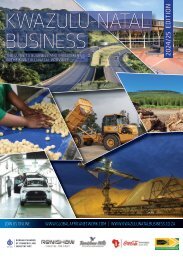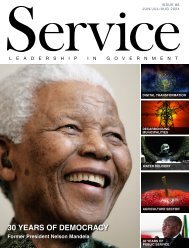KwaZulu-Natal Business 2016-17 edition
The 2016-17 edition of KwaZulu-Natal Business is the eighth issue of this highly successful publication that, since its launch in 2008, has established itself as the premier business and investment guide to the KwaZulu-Natal province in South Africa. The province is unique in terms of its abundant natural and human resources, and is also one of the key drivers behind the South African economy. To complement the extensive local, national and international distribution of the print edition of the magazine (15 000 copies), the full content can also be viewed online at www.kwazulunatalbusiness.co.za. Updated information on KwaZulu-Natal is also available through our monthly e-newsletter, which you can subscribe to online at www.globalafricanetwork.com, in addition to our other business-to-business titles that cover all nine provinces, complemented by our flagship publication, South African Business.
The 2016-17 edition of KwaZulu-Natal Business is the eighth issue of this highly successful publication that, since its launch in 2008, has established itself as the premier business and investment guide to the KwaZulu-Natal province in South Africa.
The province is unique in terms of its abundant natural and human resources, and is also one of the key drivers behind the South African economy.
To complement the extensive local, national and international distribution of the print edition of the magazine (15 000 copies), the full content can also be viewed online at www.kwazulunatalbusiness.co.za.
Updated information on KwaZulu-Natal is also available through our monthly e-newsletter, which you can subscribe to online at www.globalafricanetwork.com, in addition to our other business-to-business titles that cover all nine provinces, complemented by our flagship publication, South African Business.
Create successful ePaper yourself
Turn your PDF publications into a flip-book with our unique Google optimized e-Paper software.
OPERATING ENVIRONMENT: THE WORLD AND<br />
SUB-SAHARAN AFRICA<br />
In 2015 global economic growth remained moderate<br />
at 3.1%, and the International Monetary<br />
Fund anticipates that growth in emerging markets<br />
and developing economies will decline for<br />
the fifth consecutive year. A modest recovery<br />
has continued in advanced economies, with<br />
a gradual monetary tightening in the United<br />
States as several other major advanced economy<br />
central banks continue to ease monetary policy.<br />
Market concerns regarding the outlook for the<br />
Chinese economy have affected other economies<br />
through commodity prices, diminishing<br />
confidence and increasing volatility in financial<br />
markets. Manufacturing activity and trade remained<br />
weak globally, not only due to developments<br />
in China, but also because of subdued<br />
global demand and investment.<br />
Sub-Saharan Africa’s economic growth is<br />
estimated to have reduced sharply to 3.5% in<br />
2015 from 5.0% in 2014 as lower commodity<br />
prices have impacted on net exports, in the process<br />
placing pressure on economic activity even<br />
though lower oil prices have eased energy import<br />
costs. While economic activity remains more<br />
PROFILE<br />
robust than in many other developing regions<br />
of the world, the strong growth momentum<br />
evident in the region in recent years has not been<br />
maintained, particularly within oil-exporting<br />
countries.<br />
The 2015 economic growth forecasts for<br />
South Africa were marked down progressively<br />
during the year as the full impact of commodity<br />
price deflation and weakening business and<br />
consumer confidence limited demand. Although<br />
there was notable stabilisation of electricity<br />
supply in the second half of 2015, unfolding<br />
drought conditions, higher interest rates and<br />
policy uncertainty subdued investment and<br />
cyclical consumption; economic growth is expected<br />
to have been 1.3% in 2015, down from<br />
1.5% in 2014. A sharply weaker exchange rate (in<br />
response to investment portfolio outflows) and<br />
a continued current account deficit accompanied<br />
a broad acceleration in market volatility towards<br />
the end of the year. This was exacerbated<br />
by market concerns related to the unexpected<br />
removal of South Africa’s Minister of Finance<br />
in December.<br />
99 KWAZULU-NATAL BUSINESS <strong>2016</strong>/<strong>17</strong>


















